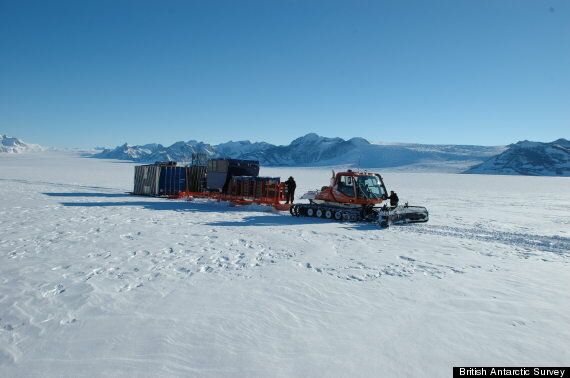It sounds a bit like the beginning of a Hollywood sci-fi thriller movie.
A team of intrepid British scientists will travel to the Antarctic to drill through two miles of ice to a subglacial lake that’s lain undisturbed for around 500,000 years.
Of course, in the all-action Hollywood version of this tale, the scientists would stumble across an alien spaceship frozen in the ice, but this expedition is tremendously exciting in its own right.

Ice one: The Ellsworth site in November 2011, with some of the equipment in place
The researchers will be investigating Lake Ellsworth and hope that it will reveal clues about whether hostile environments in space are capable of sustaining life.
For if life can survive in the extreme cold of the lake, they reason, it could survive almost anywhere.
The 12-man team are setting off in October and must travel around 10,000 miles to reach their drilling point on the West Antarctic Ice Sheet.

The equipment was towed across the Union Glacier to Lake Ellsworth
They aim to bring up water and sediment samples that they also hope will reveal vital secrets about the Earth’s past climate.
This will be the first time that sediment has been brought up from a subglacial Antarctic lake.
The trip has taken 16 years to plan and involves the deployment of some incredible, state-of-the-art equipment.
A team of engineers from the British Antarctic Survey and the National Oceanography Centre in Southampton have designed and built a titanium water-sampling probe and a bespoke sediment corer capable of being lowered down the two-mile borehole, made by a custom-built hot-water drill.

The scientists will be working in very challenging conditions. Pictured is Union Glacier
To add to the challenge every piece of technology has to be sterilised to space industry standards to ensure this unexplored lake remains pristine.
After setting up the science camp and preparing all the equipment to start the mission, the team will have just 24 hours to sample the lake before the borehole re-freezes and re-seals the lake.
Typical working conditions will be in temperatures a chilly minus 25C and wind speeds averaging 25 knots.
The team of science and engineering experts has been brought together by the mission’s Principal Investigator Martin Siegert from the University of Bristol. He said: “For the first time we are standing at the threshold of making new discoveries about a part of our planet that has never been explored in this way.
“Finding life in a lake that could have been isolated for up to half a million years is an exciting prospect, and the lake-bed sediments have the potential to paint a picture of the history of the West Antarctic Ice Sheet in a way that we haven’t seen before.
“The team’s mission is to get into the deep field and bring back clean, valid samples of lake water and lake-bed sediments, which can be brought back to the UK for in depth analysis.”
Professor John Parnell from the School of Geosciences at the University of Aberdeen said: “For years we have speculated that new forms of microbial life could have evolved in the unique habitats of Antarctica’s subglacial lakes. When we get the lake water samples back to the UK our analysis will focus on investigating the water for evidence of chemical compounds that microbes - tiny organisms - living in the lake might have produced.
“Finding evidence of such compounds would show us that if life can withstand even the deepest, darkest and most isolated conditions for more than a million years, then it has the ability to exist anywhere – and by that I mean not just on Earth.
“We will use advanced pieces of kit that allow us to analyse extremely small volumes of water – just a few millilitres – and is highly sensitive to the existence of any chemical compounds which may be present.”
The Antarctic covers a staggering eight million square miles, of which 97.6% is ice.
In places, the ice sheet is over three miles thick.
In the Antarctic, you’ll find animals such as penguins, seals and whales – and 70% of the world’s fresh water.